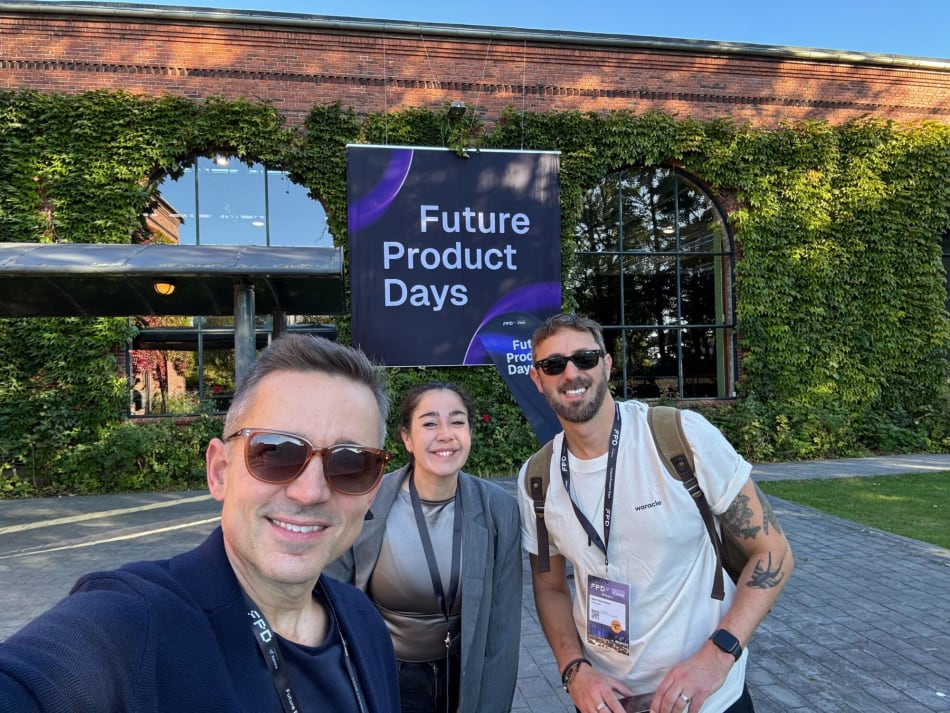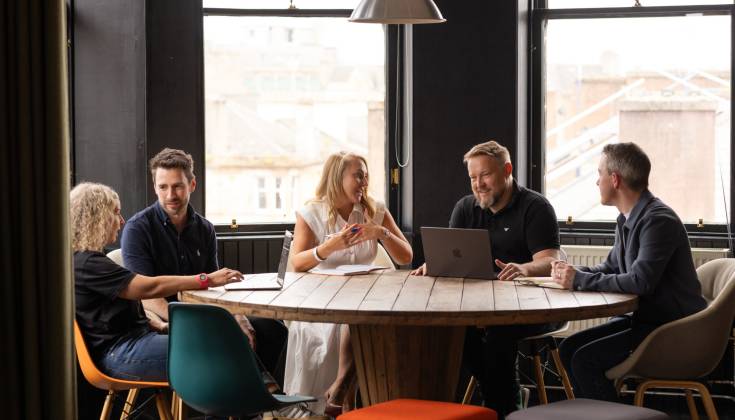
Last week, I had the pleasure of attending the Future Product Days conference in Copenhagen. The venue, an old railway manufacturing and repair centre, was the perfect backdrop, with its industrial concrete floors and remnants of old ramps and pulleys once used to build and repair steam trains from the industrial age. It felt fitting that a place once home to innovations that changed society was now hosting conversations about the next great leap: Artificial Intelligence.
Of course it would be. Like any conference this year (or the next), the prevalence of AI is undeniable. It’s a technology that has captured our imagination, and we’re only at the beginning of its widespread adoption and integration into the digital products and services we build and interact with.
However, and this might surprise you, this article isn’t about AI.
Because while AI dominated the agenda, the biggest takeaway for me was that we still need to stay inherently human. Building products for humans, by humans, is as important now as ever – arguably even more so.
Simplicity as rebellion
The day kicked off with Joacim Jeppesen (CEO, Framna), who delivered the opening keynote speech titled “Simplicity as Rebellion.” He reminded us that complexity is often an anti-pattern for success, and that innovation often lies in simplicity.
Two of his quotes really stuck with me:
“Technology moves fast but people don’t.”
So true. Just look at how radically the internet has transformed our world in just a few decades, yet people still like to send handwritten letters, and conversation in person will always have more value than a video call.
“The human spark is irreplaceable.”
I love this, and I think no matter how advanced AI becomes, keeping the spark of human innovation and intuition will always be critical when it comes to building meaningful digital products.

Language and collaboration
From Joacim’s keynote, I moved to a series of smaller stages where I found many product and design practitioners talking about their experiences. A standout was Julia Maksimchik (Netflix), who shared insights on collaboration in product development. Coming from a developer background, Julia highlighted how essential a shared language is, especially across multicultural, distributed teams.
It might sound small, but even something as simple as calling the same feature by two different names can cause confusion and delays. Products don’t build themselves, people do, and clarity in communication is foundational.
Understanding user behaviour
One of the talks I enjoyed the most came from Sarah Thompson, who presented on “The Hidden Forces Driving User Behaviour.”
She made a compelling point that the last major evolutionary leap in our brains happened 40,000 years ago. Her slide of a Neanderthal holding an iPhone got a well-earned laugh, but also made her message stick. Our instincts are still deeply rooted in survival, and they influence how we interact with technology.
Sarah explained the concepts of System 1 (fast, automatic, emotional) and System 2 (slow, deliberate, logical) thinking. These systems guide our every decision, whether we like them or not. As product managers and designers, understanding them, and designing with behavioural science in mind, can amplify our impact. We see this in concepts of gamification, but while we add badges, streaks, and icons to entice users to unlock new features, it’s about understanding why users are motivated and building around that.
She also touched on the idea that the brain is constantly evaluating the emotional cost or gain of any given situation. Anyone who’s ever filled out a value proposition canvas knows how important it is to maximise user gains while easing their pains.
Measuring what matters
Next up was Vitaly Friedman‘s talk on “How to Measure the UX Impact of Design.” What I appreciated most was how he connected design metrics directly to business outcomes. It’s easy to get buried in the details of product building and forget why we’re doing it in the first place.
His approach, mapping customer needs to outcomes, and those outcomes to business goals, was a refreshing reminder. Also, I’ll admit, I love a roadmap with OKRs. That’s the product geek in me!

You are not the user
Back on the main stage, Kate Morgan brought great energy as she tackled the common pitfall of AI features that don’t actually deliver value. Her HIPPO analogy (Highest Paid Person’s Opinion), followed by getting the whole hall to shout “You are not the user!” made me chuckle and hit the point home.
Later, Dave Crawford from Microsoft echoed this with his line, “AI is not the hammer and everything is a nail.” I couldn’t agree more. We build products to help people get things done. If AI helps with that, cool. If not, the mission remains the same. That’s always been the core of product management.
Lessons from China
The day wrapped up with Christina Boutrup, who gave a fascinating and slightly unsettling talk about Chinese super apps and the lessons to learn. Apps like Temu and WeChat offer a glimpse into a hyper-connected future, where goods and services can be purchased and delivered in hours, rather than days. Where facial recognition and a smile can underwrite a loan, and where drones can drop off a cup of coffee in a park.
In China’s more authoritarian digital environment, users are generally more comfortable with being tracked, which means the data collected can be used to drive better, more personalised outcomes. In the West, we’re more cautious. And maybe that’s where the real battleground of AI lies – how much personal data we’re willing to share in exchange for more intelligent digital experiences.
One of my favourite books, Homo Deus by Yuval Noah Harari, explores this idea. The more data we give algorithms, the better they can predict our needs, which raises important questions about privacy, personalisation, and what we’re willing to trade. I think this will be interesting to watch unfold.
So, what did I take away?
Two key things stood out:
- AI is still spoken about in third person, much like electricity once was before it became invisible and embedded in everything. AI isn’t fully integrated until it disappears into the experience.
- We must stay inherently human in the products we build. At the end of the day, behind every shiny new app or website is a person trying to do a job. Our job is to help them do it.
—
At Waracle, our mission statement is: Digital products, trusted by millions of people.
To me, the important words in that sentence are people and trust. We build great digital products for humans. They’re entrusting us to make their lives easier, not harder.
If you’d like to hear more about how we do it, we’d love to chat. Get in touch.
Authors
Head of Product
Related

Article • 05 December 2025
The art of applying stoicism to sales craft

Article • 26 November 2025
Why data infrastructure delivers value regardless of market direction

Article • 24 November 2025
Waracle accelerates growth with acquisition of Sofia-based Hacksoft

Article • 14 November 2025
Waracle secures long-term digital transformation deal with People’s Partnership

Article • 06 November 2025
AI and the coming power surge

